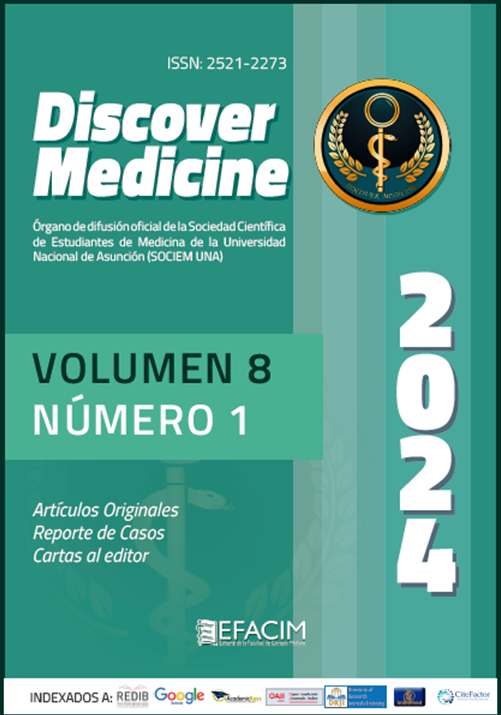Abstract
Objective: To characterize psychodermatoses due to secondary psychophysiological and psychiatric disorders at the Regional Hospital of Encarnación, during the year 2023.
Methodology: Observational, descriptive, cross-sectional research, quantitative approach. With sample size of 247.
Results: Universe of 318 chips. The average age of patients diagnosed with psychodermatosis was 35 years. There were 1.3 times more female patients. 78% (N:248) have a job occupation. Patients from different departments of Paraguay come to the Dermatology Service, with 90% of them from Itapúa. According to the classification of Koo et al, there were 1.41 percentage points more psychophysiological disorders (PSD) compared to secondary psychiatric disorders (SPD), in which the seborrheic dermatitis was identified most frequently, with 29.5% ( N:94) and, in the TPS, it was acne, with 42.1% (N: 134). All patients have received medical treatment with topical medications such as ketoconazole, in 52% (N: 165) and corticosteroids in 48% (N: 152).
Conclusion: It is considered of utmost relevance to continue the search for data that can further enrich the statistical data on psychocutaneous alterations, since it is known that the mind - body relationship contains multiple connections that can be expressed as both psychological - psychiatric and dermatological conditions and, in addition, the psychosocial impact of some dermatoses can become disabling, causing not only health problems for those who suffer from it, but also within the socio-labor context.
Keywords:. Psychodermatosis, dermatology, psychiatry. (MeSH)
References
Castillo L, Isabel García Ponce, Esther Castan Campanera, Manel J. Perfiles psicológicos de los pacientes con psicodermatosis. 2016;31(1):15-23 doi: https://doi.org/10.1016/j.piel.2015.05.009
Rumbo JM, Castellano E. Dermatología psicosomática, la relación mente y piel. Enferm Dermatol [Internet]. 2017;11(3):7-10. Disponible en: file:///E:/Usuario/Downloads/Dialnet-DermatologiaPsicosomatica-6324064.pdf
Ballén JF, Pinzón LM, Jaimes AO, et al. Trastornos psiquiátricos primarios en dermatología. Rev Asoc Colomb Dermatol [Internet]. 2016 [citado el 12 de mayo de 2023];24(2):105-121. Disponible en: https://revista.asocolderma.org.co/index.php/asocolderma/article/view/297/274
Vallejo-Pareja MA. De los trastornos somatomorfos a los trastornos de síntomas somáticos y trastornos relacionados. C Med Psicosom [Internet]. 2014 [citado el 12 de mayo de 2023];110:75-8. Disponible en: http://www.editorialmedica.com/download.php?idart=601
Prado-Díaz A. Ciencia, arte y disciplina: un cuidado integral desde las ciencias básicas. Conocimientos en Enfermería [Internet]. 2017 [citado el 12 de mayo de 2023];1(1):45-9. Disponible en: https://revistas.unilibre.edu.co/index.php/enfermeria/article/view/6051/5570
Cabrera Y, Alonso A, López E. ¿Nos enferman las preocupaciones? Una respuesta desde la Psiconeuroinmunoendocrinología. Medisur [Internet]. 2017 [citado el 12 de mayo de 2023];15(6):829-852. Disponible en: http://scielo.sld.cu/pdf/ms/v15n6/ms13615.pdf
Giner F, Lera G, Vidal M, Puchades M, Pérez A, et al. Diagnóstico y prevalencia de trastornos de la personalidad en atención ambulatoria. Estudio descriptivo. Rev. Asoc. Esp. Neuropsiq [Internet] 2015;35(128):789-799. doi: 10.4321/S0211- 57352015000400007
Koo J, Lebwohl A. Psicodermatología: la conexión entre la mente y la piel. Am Fam Physician [Internet]. 2001 [citado el 12 de mayo de 2023];64(11):1873–8. Disponible en: https://pubmed-ncbi-nlm-nih-gov.translate.goog/11764865/
Díaz-Hernández Y, del Río-Ysla M, Abrey-Terry M. Trastorno depresivo recurrente en un paciente con vitíligo. Rev Med Elec Cieg Av [Internet]. 2019 [citado el 12 de mayo de 2023). 2019;25(1). Disponible en: https://revmediciego.sld.cu/index.php/mediciego/article/view/1165/2057
Calvache N, Jaimes JJ, Candelo P, Prada C, Pineda Y, Peña E, Fierro E. Perspectiva de la dermatología y COVID-19. Rev Asoc Colomb Dermatol. 2020;28(1):17-26. DOI: https://doi.org/10.29176/2590843X.1487
Torales J, Malatesta E, González L, González I, López R, Barrios I, et al. Psicodermatología: una introducción a sus conceptos, nosología y modelos de abordaje. An. Fac. Cienc. Méd. (Asunción) [Internet]. 2020;53(2):127-136..
https://doi.org/10.18004/anales/2020.053.02.127
Lera G, Giner S, Castellano C. ¿Las enfermedades de la piel son más comunes en personas con trastornos de personalidad? Enferm Dermatol [Internet]. 2017 [citado el 12 de mayo de 2023];11(32). Disponible en: file:///E:/Usuario/Downloads/Dialnet- LasEnfermedadesDeLaPielSonMasComunesEnPersonasConT-6327409.pdf
Doglia R. The need of dermatologists, psychiatrists and psychologists joint care is psychodermatology. An. Bras. Dermatol [Internet]. 2017;92(1). DOI: http://dx.doi.org/10.1590/abd1806-4841.20175493
Šitum M, Kolić M, Buljan M. Psychodermatology. Acta Med Croatica[Internet] 2016 [citado el 12 de mayo de 2023];70(1):35-8. Disponible en: https://pubmed-ncbi-nlm- nih-gov.translate.goog/29087669/

This work is licensed under a Creative Commons Attribution-NonCommercial-NoDerivatives 4.0 International License.
Copyright (c) 2024 Andrea González Dosantos, Paddy Cimar Calvo Torales, Helena De Oliveira Medeiros
